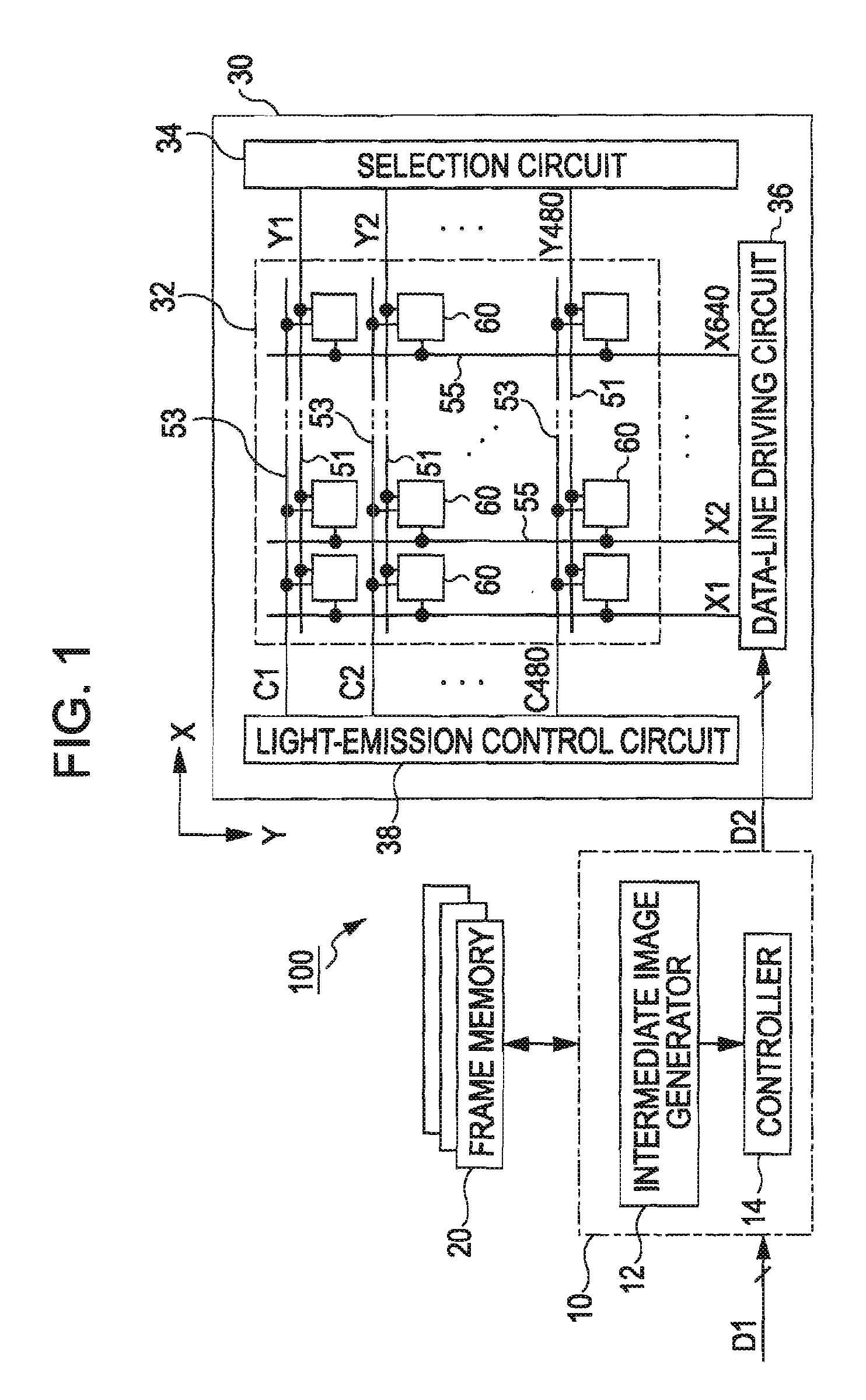Light-emitting device, driving method thereof, and electronic apparatus
- Summary
- Abstract
- Description
- Claims
- Application Information
AI Technical Summary
Benefits of technology
Problems solved by technology
Method used
Image
Examples
first embodiment
A: First Embodiment
[0057]FIG. 1 is a block diagram illustrating a configuration of a light-emitting device according to a first embodiment of the present invention. As shown in FIG. 1, the light-emitting device 100 has an image processing unit 10, a frame memory 20, and a display panel 30. The image processing unit 10 serves to generate second image data D2 from first image data D1. The first image data D1 are digital data indicating details (colors and gray scales of pixels) of frame images constituting a moving image and are supplied from a generic unit such as a CPU of an electronic apparatus mounted with the light-emitting device 100. On the other hand, the second image data D2 are digital data indicating details of an image to be substantially displayed on the display panel 30. The configuration and operation of the image processing unit 10 will be described in detail later.
[0058] The display panel 30 serves to display an image on the basis of the second image data D2 and incl...
second embodiment
B: Second Embodiment
[0081] A second embodiment of the invention will be described below. In the second embodiment described below, the same elements as those of the first embodiment are denoted by the same reference numerals and description thereof will be properly omitted.
[0082] Such a configuration has been exemplified in the first embodiment that the pixel circuits 60 are partitioned into two groups of the odd-row group and the even-row group, the pixel circuits 60 in the odd-row group are allowed to emit light in the first period Pf1, and the pixel circuits 60 in the even-row group are allowed to emit light in the second period Pf2. However, the number of groups into which the display unit 32 is divided is not limited to it in the invention. In the second embodiment, it is exemplified that a plurality of pixel circuits 60 constituting a display unit 32 are partitioned into three groups.
[0083]FIG. 9 is a diagram illustrating a partition method into groups according to the secon...
third embodiment
C: Third Embodiment
[0089] A third embodiment of the invention will be described below. Although it has been exemplified in the first embodiment and the second embodiment that a plurality of pixel circuits 60 is partitioned into groups in a unit of row, the partitioning method into groups is not limited to it. FIG. 13 is a diagram illustrating a partitioning method into groups according to the third embodiment. In the figure, squares marked by “1” indicates pixel circuits 60 belonging to a first group and squares marked by “2”, indicates pixel circuits 60 belonging to a second group.
[0090] As shown in FIG. 13, in the third embodiment, a plurality of pixel circuits 60 is partitioned into the first group and the second group so that the pixel circuits 60 of the first group and the pixel circuits 60 of the second group are adjacent to each other in both the X axis direction and the Y axis direction (that is, so that the pixel circuits 60 of the second group are adjacent to a pixel circ...
PUM
 Login to View More
Login to View More Abstract
Description
Claims
Application Information
 Login to View More
Login to View More - R&D
- Intellectual Property
- Life Sciences
- Materials
- Tech Scout
- Unparalleled Data Quality
- Higher Quality Content
- 60% Fewer Hallucinations
Browse by: Latest US Patents, China's latest patents, Technical Efficacy Thesaurus, Application Domain, Technology Topic, Popular Technical Reports.
© 2025 PatSnap. All rights reserved.Legal|Privacy policy|Modern Slavery Act Transparency Statement|Sitemap|About US| Contact US: help@patsnap.com



